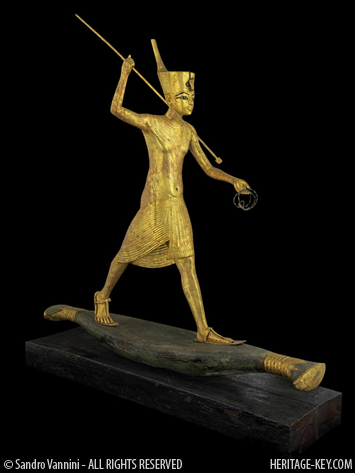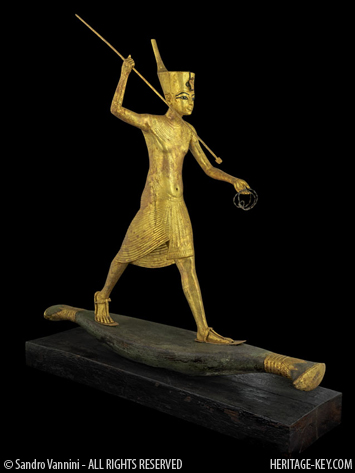Archaeologists have made two major tomb discoveries at the ancient city of Petra in southern Jordan. They discovered a rock-cut tomb that contained the skeletal remains of 61 individuals, along with a wealth of wooden artefacts, animal bones and ceramics. The second discovery was made at a place called tomb 676. While excavating it archaeologists found a gold medallion with an Islamic inscription on it. The find dates to long after the tomb was abandoned. “This object was placed in the tomb in a later period – perhaps as a way of warding off evil coming from the tomb,” said Professor David Johnson, of Brigham Young University in Utah, who led the team that made both tomb…
-
-
Five years ago an archaeological team broke news of a major find that forever changed our views about the history of the Middle East. Researchers from the Oriental Institute at the University of Chicago, and the Department of Antiquities in Syria, announced in a press release that they had found the “earliest evidence for large scale organized warfare in the Mesopotamian world.” They had discovered that a city in Syria, named Hamoukar, had been destroyed in a battle that took place ca. 3500 BC by a hostile force. Using slings and clay bullets these troops took over the city, burning…
-
Question – who can completely fill up a cavernous 1,500 seat domed hall on a Saturday night in Toronto? Answer – Dr. Zahi Hawass “I don’t get to introduce rock stars,” said Art Gallery of Ontario CEO Matthew Teitelbaum. Well tonight he did. Forget the critical New Yorker article, the mixed reviews of the new Tut exhibition at the Art Gallery of Ontario, or the fact that local Toronto media largely stayed away from this lecture. The world’s most well-known Egyptologist completely filled Convocation Hall, with people who had all paid a small admission fee (no more than $18) to…
-
Researchers have discovered that 19 objects in New Yorks Metropolitan Museum of Art are from King Tuts tomb, and an agreement has been struck that will see them be returned to Egypt. The research indicates that Howard Carter kept a few pieces which were bequeathed to the Met after his death in 1939. The artefacts are quite small and at the time it was not known that they were from the tomb itself. Fifteen of the 19 pieces have the status of bits or samples, read a Supreme Council of Antiquities Press release. The remaining four are of more significant…
-
New research on a 2,400 year old star table shows that the Ancient Egyptians kept close tabs on the Big Dipper, monitoring changes in the constellations orientation throughout the course of an entire year. The Big Dipper is composed of seven stars and is easily viewable in the northern hemisphere. Its shape looks like a ladle with a scoop attached. Ancient Egyptians represented it as an oxs foreleg. If a personwere to observethe constellationat the exactsame time every night they would see it gradually move counter-clockwise each time they saw it. Professor Sarah Symons, of McMaster University in Hamilton Canada,…
-
A new study shows that Tutankhamun, Egypts famous boy-king who died around the age of 18, suffered a massive crushing tearing injury to his chest that likely would have killed him. X-rays and CT scans have previouslyshown that the pharaohs heart, chest wall, the front part of his sternum and adjacent ribs, are missing. In Ancient Egypt the heart was like the brain and removing it was something that was not done. The heart, considered the seat of reason, emotion, memory and personality, was the only major organ intentionally left in the body, writes Dr. Robert Ritner in the book…
-
Dr Michel Baud of the Louvre Museum in Paris gave an interesting lecture last week about his excavations of a pyramid at Abu Roash. The monument was badly preserved and its stone had been quarried in Roman times, but the certain details, such as its apparent solar connections, were still discernable. Earlier, Vassil Dobrev stated that the pyramid may actually be a solar temple. However, Baud dismisses these claims…. Nearly 4,500 years ago, in the time of the Old Kingdom, the pharaoh Khufu built one of the greatest monuments on earth – the Great Pyramid. His pyramid was actually a complex of monuments…
-
A new study shows that Tutankhamun, Egypt’s famous “boy-king” who died around the age of 18, suffered a “massive crushing tearing injury to his chest” that likely would have killed him. X-rays and CT scans have previously shown that the pharaoh’s heart, chest wall, the front part of his sternum and adjacent ribs, are missing. In Ancient Egypt the heart was like the brain and removing it was something that was not done. “The heart, considered the seat of reason, emotion, memory and personality, was the only major organ intentionally left in the body,” writes Dr. Robert Ritner in the book Ancient Egypt.
-
A new discovery made by Dr. Zahi Hawass and his team shows that an ancient pharaoh made serious efforts to save the Sphinx. At Giza his team found the remains of a mudbrick enclosure wall that would have surrounded the Sphinx, perhaps protecting it from sand blown by wind. Made of mudbrick, the first section runs to the east of the Sphinx for 86 meters north-south and is 75 cm tall. The second section is 46 meters long, 90 cm in size, and runs east-west along the perimeter of Khafre’s valley temple. The two sides converge in the southeast. Archaeologists are already aware…
-
Toronto is the place to be this week for fans of ancient Egypt. Especially if youre interested in the gruesome ways that two of its pharaohs might have died. King Tut: Death by Hippo? This Wednesday, at 7 pm at theU of Tcampus, Dr. Benson Harer of California State University at San Bernardinowill argue that King Tutwasmauled to death by a hippo his lecture istitled”What really killed King Tut: The Hippo Heresy.” Dr. Harer is a medical doctor and adjunct professor of Egyptology atCalifornia State so he brings a unique perspective to this issue. Indeed, the death of King Tut…




